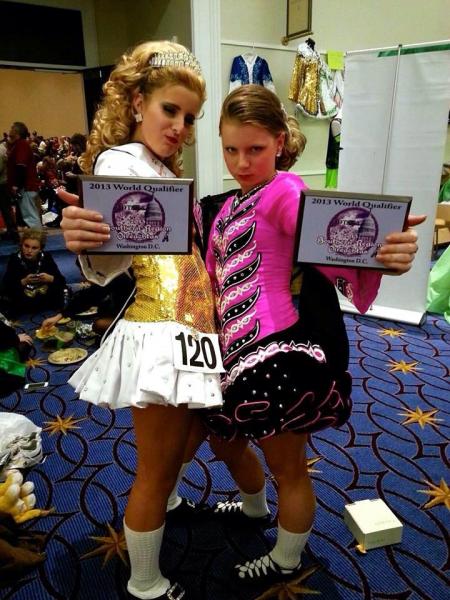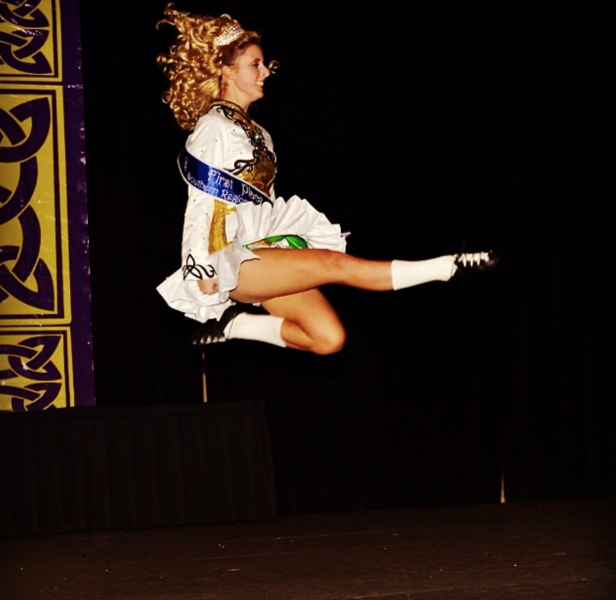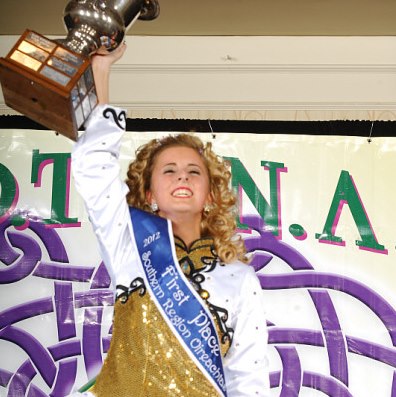An Inside Look Into The World Of Competitive Irish Dance

I’ll be honest, last weekend was really hard. Not because of the constant throbbing in my arms from crutching all around campus, not because of the intermittent fiery pain that appears in my left foot with no warning, but because I see photos on Facebook from regionals, and I miss it. I miss the world of Irish dance.
My Irish dancing talent has defined my whole life. My friends always knew I was busy every first week of December, off to some crazy competition they could hardly pronounce. This weekend marks the first time in 11 years I won’t make the trip to the Southern Region “Oireachtas” (pronounced O-rock-tus, an Irish word for “gathering” we use for regional competitions).
Ironically, I’m not there because of injuries I’ve sustained from my 15-year dance career.
READ MORE: L.A. Contemporary Dance Company Moves As One
On November 24, I underwent surgery to replace some dislocated joints in my left foot. This injury has plagued me since I was in sixth grade, when an unfortunate run-in with a moon bounce left me with a joint bone broken in half.
As I started moving up the ranks of my age group around seventh grade, my goals started getting bigger. Soon, my ambition was unquenchable.
By high school I was in the big leagues, qualifying for the World Championships and pushing myself into the top ten in my region. My senior year, I was Oireachtas Champion for my age group, making me #1 in the entire southern United States.
This entire time, I ignored the pain in my foot for the sake of pushing my dance career further, not fully realizing that it was the reason for that pain in the first place.
READ MORE: Theater Review: "Riverdance" at the Pantages Theater
The only way I could describe to you what it feels like to dance one of my routines full out, from start to finish, is to say it’s intense, choreographed sprinting for a minute-and-a-half straight. While simply remembering my routine, I have to focus on keeping my arms pinned to my sides, having my feet turned out and crossed at the knee, making sure my heels don’t hit the ground unless they’re supposed to, and keeping a cheesy smile plastered on my face. Did I mention I have to do all this while dodging another competitor dancing on stage with me at the same time? Oh and don't forget the handmade, two-thousand-dollar costumes, full make-up and curly wigs we have to wear for show.
To an outsider, this world is insane. To an Irish dancer, we couldn't imagine it any other way.
Irish dance, to its very core, is designed to put intense stress on your body. For example, the rock move is a traditional move that quite literally looks like rolling your ankle over and over. In 2010, researchers for the Journal of Dance Medicine and Science concluded that the contact force at the ankle joint was 14 times a dancer’s body weight. For a 115-pound dancer, that’s 1,610 pounds of force directed solely at the ankle joint.

READ MORE: The BalletBoyz At The Music Center: Meet Leon Poulton
My worst flaw in my dance career was my heavy shoes. My dance teacher and I called them my “lucky shoes” because I achieved every major accomplishment to date wearing those shoes. The trusty heavies I’ve owned since I was 12 years old, however, should have been traded out for new ones years ago.
The supportive insoles with the shoes were shot by the time I was probably 14. Every move I’ve made since then has only worsened the condition of my already injured foot. By the time I got the surgery in November, I couldn’t even walk to class without feeling pain in my left foot.
So, even though I probably won't see the inside of a dance studio 'til my friends go off to the World Championships in April, I still think this was my best choice for my dance career. At Worlds last year, my dancing had taken a serious toll because I couldn't handle any more six-hour workshops and outside endurance training beyond running maybe a mile on a treadmill.
I may not be so much as walking now, but I will be able to dance better than ever once I get past all the surgeries and the physical therapy.
It's crazy to think that I've put this off for so long; I just thought permenant injuries were a necessity of the sport.
Just last week, a girl I used to compete with came and visited USC. She was just an old friend of one of my best friends here, but our paths had never really crossed in the dance world because she was older than me. But, as we sat on the bus going to my sorority invite, the entire way there, we talked non-stop about dance -- mutual competitors, judges we loved (or hated), and most importantly, injuries.
Being at that international level, dancers bond over the fact that every single one of us has a laundry list of injuries. Besides my joints, I've torn my hip flexer, I've broken about six toes, spained both ankles countless times, and I can't remember the last time I didn't have shin splints. My best friend Isabel has broken her foot twice, on the same move in her soft shoe dance two years in a row. My sister was plagued by stress fractures that forced her to retire from dance.
And I'm not just surrounded by unlucky people; this is normal for Irish Dance.
The physical toughness this obscure sport and art form requires is often too much for some. Countless dancers fall to injuries simply because they're done feeling like they're destroying their body for dance.

Overcoming the mental game of Irish dance is the other key to a dancer's success. Competition is fierce, and oftentimes your best friends are your biggest rivals. Sometimes you're dancing for an audience of 50, and sometimes it's a ballroom of hundreds - if not thousands - at international competitions.
Judging is inherently subjective, so some days, even your very best isn't enough.
I've seen many dancers crumble under that kind of pressure, where the odds seem totally against you and you still have to put a smile on your face like everything's okay. Hell, I've even seen a girl puke on the stage at Worlds. It's absolutely terrifying if you let your nerves get to you.
What separates the good from the great in Irish dance, however, are the girls who waltz on stage like they own the place. They choke back those nerves for that minute and a half and make the judges look at them.
Though no monetary reward is ever on the line, the Irish dance world values the hard work and showmanship its dancers require, making every title - regional, national or global - one highly coveted. The underdog is never underestimated, and the champion’s place is never guaranteed.
It is these qualities of Irish dance that make me proud to be a part of this special little world, even if it’s resulted in twelve agonizing weeks of crutches. I'm proud that I know how awesome it feels to dance combinations like this, this and this, and I can't wait till I can again.
I sit on my couch today, envious of my friends in Orlando standing on top of the podium. But I also proudly look back on memories of when I once stood in their place and applaud those dancers now, knowing the dedication it took to get there.
Contact Staff Reporter Alana Bracken here and follow her on Twitter here.



